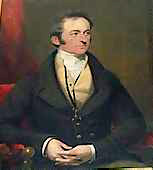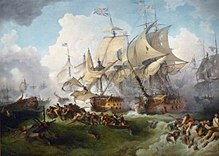George Dundas (Royal Navy officer)
George Dundas | |
|---|---|
 George Heneage Lawrence Dundas | |
| Birth name | George Heneage Lawrence Dundas |
| Born | 8 September 1778 Upleatham,Yorkshire |
| Died | 7 October 1834(aged 56) Upleatham, Yorkshire |
| Allegiance | |
| Service/ | |
| Years of service | 1800–1834 |
| Rank | Rear Admiral |
| Commands held | First Naval Lord Comptroller of the Navy HMSCameleon HMSCalpe HMSQuebec HMSEuryalus HMSEdinburgh |
| Battles/wars | French Revolutionary Wars War of the Fifth Coalition War of the Sixth Coalition |
| Awards | Companion of the Order of the Bath |
Rear AdmiralThe Hon.George Heneage Lawrence DundasCB(8 September 1778 – 7 October 1834) was a senior officer in theRoyal Navy.As a junior officer he came to prominence due to his brave conduct during a fire on the first-rateHMSQueen Charlotte.As a result of this he was appointed to the command of the sixth-rateHMSCalpein which he took part in theBattle of Algeciras Bayin July 1801 during theFrench Revolutionary Wars.After serving for four years asWhigMember of ParliamentforRichmond,he was given command of the fifth-rateHMSEuryalusand took part in the unsuccessfulWalcheren Campaignin July 1809 during theNapoleonic Wars.He transferred to the third-rateHMSEdinburghand landed troops atViareggioinItalyin November 1812 later in that War. He went on to be Member of Parliament forOrkney and Shetlandand becameFirst Naval Lordin theFirst Melbourne ministryin August 1834 but died in office just two months later in October 1834.
[edit]
Early career[edit]
Born the fifth son ofThomas Dundas(createdBaron Dundasin 1794) by his wife Charlotte Dundas (daughter ofWilliam Fitzwilliam, 3rd Earl Fitzwilliam), Dundas became alieutenantin theRoyal Navyin 1797 and served for several years with theMediterranean Fleet.[1]
HMSQueen Charlotte[edit]

In February 1800 Dundas was aboardLord Keith's flagship, the first-rateHMSQueen Charlotte.Dundas was junior to LieutenantLord Cochranebut Cochrane had taken command ofNelson's prize, theGenereaux,in late 1799 to take her into port; Dundas therefore became 5th Lieutenant of theQueen Charlotte.One month later, early in the morning of 17 March 1800, cries of "Fire" rang out throughout the vessel. Some hay lying under the half-deck had been set on fire by a match kept there for the signal guns. Dundas was in the forecastle where he organized fire-fighting efforts. Dundas led a party below decks where they secured the main and fore hatches and then opened the lower-deck ports and the sea cocks to flood the lower decks to prevent the fire spreading down. These efforts delayed the fire from reaching the twomagazines.Dundas continued working below decks until some middle-deck guns fell through the deck. At about 9am Dundas climbed out the foremost lower-deck port and climbed up to the forecastle, joining the about 150 men there who were throwing water on the fire.[2]Despite the crew's exertions, theQueen Charlotteeventually blew up with the loss of 673 people out of its complement of 840 officers, men and boys, including the Captain and her first Lieutenant. Dundas however survived.[3]
HMSCameleon[edit]
By 14 June 1800 Dundas was captain of the sloopCameleon.She andSalamineshared in the capture on that day of the Genoese brigAnima Purgatoria,which was sailing from Bastia to Salcolight.[4]
HMSCalpe[edit]
Next, Dundas was appointed to the command of the sixth-rateHMSCalpe.[5]On the night of 27 October 1800,Francis Beaufort,inventor of theBeaufort Wind-Scale,had ledPhaeton's boats on a cutting out expedition. They captured theSan José,aliasAglies,of 14 guns, which they immediately re-commissioned under the name of HMSCalpe,the ancient name of Gibraltar. Although it would have been usual to promote Beaufort, the successful and heroic leader of the expedition, to commandCalpe,Lord Keithchose instead to promote Dundas who not only was not present at the battle, but was junior to Beaufort.[6]Dundas was promoted tocommanderin December 1800.[1][3]
In July 1801 Dundas was in command ofCalpeat theBattle of Algeciras Bay.After the third-rateHMSHannibalgrounded, Dundas, deceived by a signal from her, sent his boats to saveHannibal's crew. The French detained the boats and their crews, includingCalpe's lieutenant, Thomas Sykes; after firing several broadsides at the enemy's shipping and batteries, Dundas andCalpereturned to Gibraltar.[7]In the subsequent second phase of the Battle of Algeciras Bay, the two Spanish first-ratesReal CarlosandHermenegildofired upon each other during the night, caught fire and exploded, with tremendous loss of life. The British captured the third-rateSt Antoine,withSuperbandCalpethen assisting in securing the prize and removing the prisoners.[8]Rear AdmiralJames Saumarezpromoted Dundas topost-captainon 9 August 1801[1][3]and Dundas took command ofSt Antoine,which he sailed back to England.[5]
Politics[edit]
After thepeace of 1802,Dundas entered politics becomingWhigMember of ParliamentforRichmondin the1802 general election[9]but resigned in February 1806, using the device of applying to beSteward of the Manor of East Hendred,to take up an offer of a naval command again and to allow his brotherCharlesto re-enter Parliament.[1]In February 1805, he was given command of the fifth-rateHMSQuebec.[5]
HMSEuryalus[edit]
In January 1806 Dundas took command of fifth-rateApollo-classfrigateHMSEuryalus.[10]Euryaluswas asked, along withHMSOceanand several other warships to act as escorts to a large convoy bound for Oporto, Lisbon and the Mediterranean. Towards the end of 1807Euryalusreturned to England withNigeras escort to a convoy of several thousand troops underSir John Moorefrom Gibraltar. She went into dock at Plymouth for a refit and was then stationed in the North Sea.[11]She carried theDuke d'Angoulêmefrom Yarmouth to Gottenburg and escorted the Baltic convoys through theGreat Belt.[11]
In June 1808 Dundas discovered several vessels at anchor at the entrance ofNakskovclose into the shore. He anchored and sent four boats to destroy them. They burnt two large troop transports and captured a gun-vessel armed with two 18-pounders and carrying 64 men. The enemy lost seven men killed and twelve wounded, as well as many drowned; the British had one man slightly wounded.[12]During the same year Dundas went toElbing,a small port in West Prussia about 60 kilometers east ofDantzig(now in Poland) to embarkPrincess Marie Josephine Louise of Savoy(the consort ofLouis XVIII), the Duc du Berry and other members of the French royal family. He took them toCarlscronain southern Sweden and, after re-embarking them atGottenburg,finally to Harwich.[11]
Dundas was also involved in theWalcheren Campaignin July 1809 when a British armed force of 39,000 men landed onWalcheren.Euryalusjoined the squadron which forced the passage of theScheldtbetween the batteries at Flushing and Cadsand on 11 August 1809.Euryalushad no casualties although two men were killed and nine wounded in the other ships.[13]Later she was stationed offCherbourgunder the orders of CaptainSir Richard King,and in November 1809 she captured the French privateer luggerEtoileof 14 guns and 48 men.[14]In the spring of 1810Euryalusescorted a large convoy from Spithead to Portugal and the Mediterranean and was then attached to Captain Blackwood's inshore squadron off Toulon.[11]
Early in 1811 Dundas temporarily took command of the 74-gunthird rateAchilleuntil relieved by CaptainAiskew Paffard Hollis,who had transferred fromStandard.Dundas then returned toEuryalus.On 7 June 1811 the boats ofEuryalusandSwallowcaptured the French privateerIntrepideoff Corsica after a long chase. She had a crew of 58 and was armed with two 8-pounders.[15]
Dundas became Member of Parliament for Richmond again at a by-election in 1812 but was defeated at the1812 general election.[1]
HMSEdinburgh[edit]

In October 1812 Dundas transferred to the 74-gunThird RateEdinburgh.In 1813 Dundas andEdinburghwere in the Mediterranean. On the morning of 5 October,Edinburghjoined Capt. Duncan ofImperieuseoffPorto D'Anzowhere he andResistance,Swallow,EclairandPyladeshad been watching a convoy for some days with the intention of attacking it.[16]The place was defended by two batteries mounting three heavy guns each on themole,a tower with one gun and a battery with two guns. During the attack in the afternoon,EdinburghsupportedEclairandPyladesas they bore up against the battery to the south. After the ships opened fire, landing parties brought out the 29 vessels of the convoy, 20 of which were laden with wood for the arsenal at Toulon. All the works were blown up.[16]
On 30 November 1812 Dundas was placed in command of a small squadron consisting ofEdinburgh,FurieuseandTermagantwhich landed troops atViareggioinItaly.Some 600 cavalry and infantry from theLivornogarrison attacked the British troops, who routed them, capturing two field pieces and a howitzer. From the prisoners they learned of the weak state of the garrison and asked to be re-embarked to be taken to Livorno. The British troops and Marines landed on the evening of 13 December and they occupied the suburbs of the town. Some 700 cavalry and infantry attacked the marines, who opened to let the cavalry pass through them. The marines charged, killing, wounding or taking prisoner between 250 and 300 men.Edinburghhad just three marines wounded.[17]
Post-war[edit]
At the end of the war, Dundas left theEdinburghat Genoa and traveled overland back to Britain. After retiring from the Navy in 1815,[1]he became aCompanion of the Baththat year.[5]
Dundas won a seat as Member of Parliament forOrkney and Shetlandat the1818 general electionbut was defeated at the1820 general election.[1]He again became Member of Parliament for Orkney and Shetland at the1826 general electionbut was defeated again at the1830 general election.[1]He was also promoted torear-admiralin 1830.[18]
Dundas becameSecond Naval Lordin theGrey ministryin November 1830; having been appointed aDeputy LieutenantofYorkin 1831.[19]On 2 November 1831 he was appointed asComptroller of the Navyand member of theNavy Boarduntil June 1832[20]when it was abolished and its functions were merged with theBoard of Admiralty.He was elevated toFirst Naval Lordin theFirst Melbourne ministryin August 1834[21]but died in office, unmarried, ofapoplexyatUpleathaminNorth Yorkshirejust two months later on 7 October 1834.[3]He is buried atMarskein North Yorkshire.[3]
Fictional references[edit]
A heavily fictionalized Dundas appears in several ofPatrick O'Brian'sAubrey-Maturinnovels, as the oldest friend of CaptainJack Aubrey,and as (fictionally) the son ofFirst Lord of the AdmiraltyHenry Dundas, 1st Viscount Melville,and the younger brother ofFirst Lord of the AdmiraltyRobert Dundas, 2nd Viscount Melville.[22]
Dundas is a peripheral character inC. Northcote Parkinson's 1976 novelTouch and Gowho, like O'Brian, places his hero at the Battle of Algeciras, where he interacts with Dundas.[23]
References[edit]
- ^abcdefgh"George Heneage Lawrence Dundas".UK Parliament.Retrieved13 January2013.
- ^James (1837), Vol. 3, p. 7
- ^abcde"Naval Chronicle".Elliott Dundas. Archived fromthe originalon 16 July 2012.Retrieved13 January2013.
- ^"No. 15278".The London Gazette.22 July 1800. pp. 843–844.
- ^abcdUrban, p. 319.
- ^James (1837), Vol. 3, p. 56
- ^James (1837), Vol. 3, p. 118
- ^James (1837), Vol. 3, p. 128
- ^"No. 15499".The London Gazette.20 July 1802. p. 767.
- ^Winfield (2008), p.155-6
- ^abcdMarshall (1824), Vol. 2, p.421-3
- ^"No. 16161".The London Gazette.9 July 1808. p. 965.
- ^James (1837), Vol. 5, p.136
- ^"No. 16315".The London Gazette.14 November 1809. p. 1826.
- ^"No. 16512".The London Gazette.10 August 1811. pp. 1571–1572.
- ^abJames (1837), Vol. 6, p. 34
- ^"No. 16847".The London Gazette.22 January 1814. pp. 178–179.
- ^"No. 18709".The London Gazette.23 July 1830. p. 1541.
- ^"No. 18828".The London Gazette.26 July 1831. p. 1506.
- ^"DUNDAS, Hon. George Heneage Lawrence (1778-1834), of Upleatham Park, Yorks. and Arlington Street, Mdx. History of Parliament Online".historyofparliamentonline.org.The History of Parliament Trust 1964-2017.Retrieved31 August2017.
- ^Sainty, J C (1975)."'Lord High Admiral and Commissioners of the Admiralty 1660–1870', Office-Holders in Modern Britain: Volume 4: Admiralty Officials 1660–1870 ".pp. 18–31.Retrieved13 January2013.
- ^O’Brian, Patrick (2011).Post Captain (Aubrey/Maturin Series, Book 2).Harper Collins.ISBN978-0007429295.
- ^Parkinson, C. Northcote (1978).Touch and Go.G. K. Hall.ISBN978-0816165926.
Sources[edit]
- James, William (1837).Naval History of Great Britain 1793 – 1827 (London).ISBN978-1116143119.Archived fromthe originalon 2 July 2008.Retrieved13 January2013.
- Marshall, John (1824).Royal Naval Biography; Or Memoirs of the Services of All The Flag-Officers, Superannuated Rear-Admirals, Retired Captains, Post-Captains And Commanders.Kessinger.ISBN978-0-548-24427-2.
- Urban, Sylvanus (1835).The Gentleman's Magazine, Vol. 157.John Bowyer Nichols & Son.
- Winfield, Rif (2008).British Warships in the Age of Sail 1793–1817: Design, Construction, Careers and Fates 2nd edition.Seaforth Publishing.ISBN978-1-84415-717-4.
External links[edit]
- First Sea Lords and Chiefs of the Naval Staff
- Lords of the Admiralty
- Younger sons of barons
- 1778 births
- 1834 deaths
- Members of the Parliament of the United Kingdom for English constituencies
- Members of the Parliament of the United Kingdom for Orkney and Shetland
- UK MPs 1802–1806
- UK MPs 1807–1812
- UK MPs 1818–1820
- UK MPs 1826–1830
- Companions of the Order of the Bath
- Royal Navy rear admirals
- 19th-century Royal Navy personnel
- Clan Dundas

